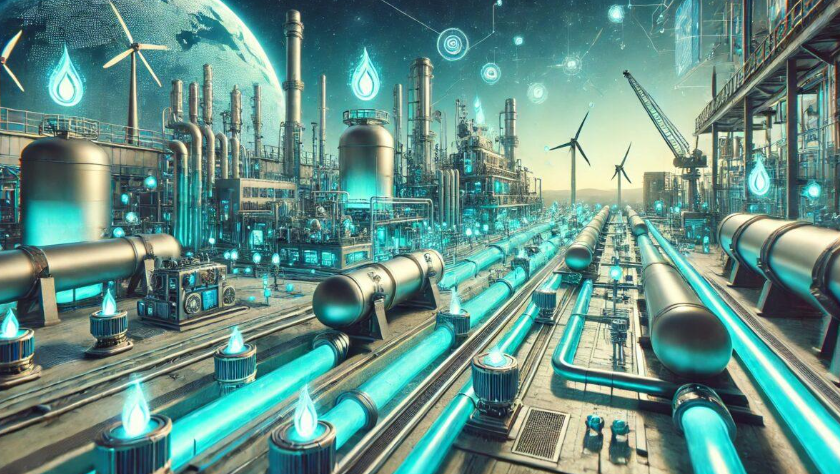Information
• 02/15/2025TURQUOISE HYDROGEN – A GAME CHANGER?
Turquoise hydrogen production emerges as a promising solution for the industry, offering a more sustainable and efficient method that could accelerate the global energy transition and reduce carbon emissions alongside green hydrogen.
TURQUOISE HYDROGEN – A GAME CHANGER?

In the race to curb global warming and ensure a sustainable future, the energy transition is becoming increasingly urgent. The need to reduce dependence on fossil fuels like oil highlights alternatives such as hydrogen. Green hydrogen, widely recognized for its low environmental impact, is already emerging as a promising solution, but now another competitor is entering the energy landscape: turquoise hydrogen. This new form of hydrogen production has the potential to revolutionize the industry and accelerate the energy transition, while offering an innovative and cleaner approach to energy generation.
THE IMPORTANCE OF HYDROGEN IN THE ENERGY TRANSITION: WHY WE’RE LOOKING AT TURQUOISE HYDROGEN
Hydrogen is the most abundant element in the universe, but its extraction requires specific processes. It isn’t found in isolation in nature, always being bonded to other elements, such as in water molecules, natural gas, and biological materials.
For this reason, hydrogen extraction methods play a crucial role in the environmental impact of its use as an energy source. In this context, different forms of hydrogen emerge, each with varying degrees of environmental impact and potential to drive the energy transition.
Green hydrogen is already a well-known solution, produced through water electrolysis powered by renewable energy sources like solar and wind energy. However, turquoise hydrogen is now gaining momentum as an intermediate alternative between the more polluting gray hydrogen and the cleaner green hydrogen.
Turquoise hydrogen is generated through methane pyrolysis (natural gas), a process that does not release carbon dioxide (CO?) directly into the atmosphere but instead produces solid carbon, which can be used in other industries.
TURQUOISE HYDROGEN: A PROMISING ALTERNATIVE TO REDUCE EMISSIONS AND REVOLUTIONIZE INDUSTRY
Turquoise hydrogen has proven to be a promising solution for industries seeking to reduce their greenhouse gas emissions. Unlike gray hydrogen, which is produced from the combustion of natural gas and releases CO? into the atmosphere, turquoise hydrogen uses methane in a pyrolysis process. This process converts methane into hydrogen and solid carbon without releasing CO?, making it a cleaner and more efficient alternative.
In addition to its potential in the energy transition, the solid carbon byproduct generated from turquoise hydrogen production also has applications in industry. It can be used in the manufacturing of tires, graphite, dyes, and even in the steel industry, highlighting the versatility of this technology. However, for turquoise hydrogen to be truly a sustainable solution, it is essential that the life cycle of this byproduct is well managed, ensuring that its disposal does not create new environmental problems.
COMPARISON BETWEEN GREEN HYDROGEN AND TURQUOISE HYDROGEN: WHICH IS THE BETTER OPTION FOR THE ENERGY TRANSITION?
While green hydrogen is produced through the electrolysis of water using renewable energy sources such as solar and wind power, turquoise hydrogen offers an alternative by utilizing natural gas with less environmental impact than gray hydrogen. The production of turquoise hydrogen involves breaking down methane without releasing CO?, making this type of hydrogen an attractive option for the energy transition.
Despite the promising advancements, most turquoise hydrogen projects are still in early or pilot phases. This means that while it is a promising technology, it still needs to scale up to compete directly with green hydrogen in terms of efficiency and cost. On the other hand, green hydrogen is increasingly being explored on a large scale, particularly in Brazil, where the Northeast is emerging as a strategic region for the production of this type of energy.
HYDROGEN IN INDUSTRY: HOW GROWING DEMAND DRIVES TURQUOISE HYDROGEN PRODUCTION
As the world moves toward a low-carbon future, the demand for hydrogen, in all its forms, is expected to grow exponentially. According to estimates, hydrogen demand could increase two to four times by 2050. This growth will create pressure on both green and turquoise hydrogen production, as both will be essential to meet the industry's rising demand.
Most of the hydrogen generated so far is used in sectors such as oil refining and ammonia production for fertilizers. However, expectations are that new industries, including the steel and transportation sectors, will become major consumers of hydrogen. Turquoise hydrogen, with its ability to produce hydrogen without direct CO? emissions, could become a crucial solution for these industries, especially those struggling to fully adopt renewable energy sources.
Source: Valdemar Medeiros at https://clickpetroleoegas.com.br/ (October 4, 2024).





